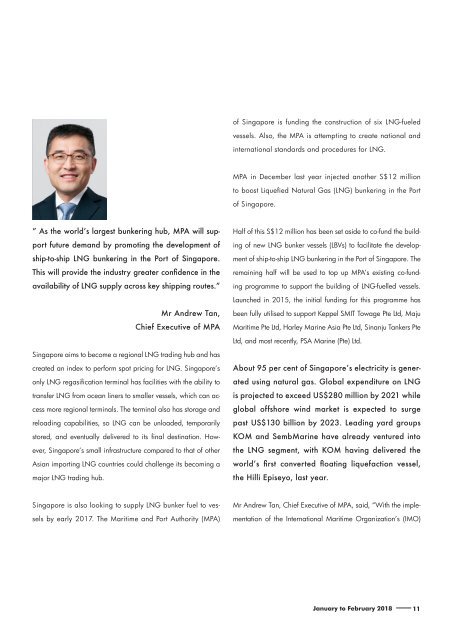Petromin marine and offshore Jan-Feb Issue
You also want an ePaper? Increase the reach of your titles
YUMPU automatically turns print PDFs into web optimized ePapers that Google loves.
of Singapore is funding the construction of six LNG-fueled<br />
vessels. Also, the MPA is attempting to create national <strong>and</strong><br />
international st<strong>and</strong>ards <strong>and</strong> procedures for LNG.<br />
MPA in December last year injected another S$12 million<br />
to boost Liquefied Natural Gas (LNG) bunkering in the Port<br />
of Singapore.<br />
” As the world’s largest bunkering hub, MPA will support<br />
future dem<strong>and</strong> by promoting the development of<br />
ship-to-ship LNG bunkering in the Port of Singapore.<br />
This will provide the industry greater confidence in the<br />
availability of LNG supply across key shipping routes.”<br />
Half of this S$12 million has been set aside to co-fund the building<br />
of new LNG bunker vessels (LBVs) to facilitate the development<br />
of ship-to-ship LNG bunkering in the Port of Singapore. The<br />
remaining half will be used to top up MPA’s existing co-funding<br />
programme to support the building of LNG-fuelled vessels.<br />
Launched in 2015, the initial funding for this programme has<br />
Mr Andrew Tan,<br />
Chief Executive of MPA<br />
been fully utilised to support Keppel SMIT Towage Pte Ltd, Maju<br />
Maritime Pte Ltd, Harley Marine Asia Pte Ltd, Sinanju Tankers Pte<br />
Ltd, <strong>and</strong> most recently, PSA Marine (Pte) Ltd.<br />
Singapore aims to become a regional LNG trading hub <strong>and</strong> has<br />
created an index to perform spot pricing for LNG. Singapore’s<br />
only LNG regasification terminal has facilities with the ability to<br />
transfer LNG from ocean liners to smaller vessels, which can access<br />
more regional terminals. The terminal also has storage <strong>and</strong><br />
reloading capabilities, so LNG can be unloaded, temporarily<br />
stored, <strong>and</strong> eventually delivered to its final destination. However,<br />
Singapore’s small infrastructure compared to that of other<br />
Asian importing LNG countries could challenge its becoming a<br />
major LNG trading hub.<br />
About 95 per cent of Singapore’s electricity is generated<br />
using natural gas. Global expenditure on LNG<br />
is projected to exceed US$280 million by 2021 while<br />
global <strong>offshore</strong> wind market is expected to surge<br />
past US$130 billion by 2023. Leading yard groups<br />
KOM <strong>and</strong> SembMarine have already ventured into<br />
the LNG segment, with KOM having delivered the<br />
world’s first converted floating liquefaction vessel,<br />
the Hilli Episeyo, last year.<br />
Singapore is also looking to supply LNG bunker fuel to vessels<br />
by early 2017. The Maritime <strong>and</strong> Port Authority (MPA)<br />
Mr Andrew Tan, Chief Executive of MPA, said, “With the implementation<br />
of the International Maritime Organization’s (IMO)<br />
<strong>Jan</strong>uary to <strong>Feb</strong>ruary 2018 11


